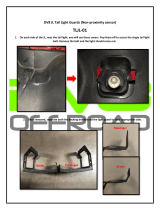
2
SECTION 1
GENERAL INFORMATION
On vehicles manufactured from August 15 of 2002, the four or
five digit serial number begins with one of the following prefix:
C - Conquest
R - Response
B - Bigfoot
N - Vanguard2 (Mechanical Brakes)
S - Vanguard (Hydraulic Brakes)
A - Conquest 6x6
V - Avenger 8x8
Carefully observe the maximum load capacity for your vehicle
on land and in water as listed in the following:
ARGO 6 x 6 VANGUARD (S)
Serial Number: S-6999
Engine: Briggs & Stratton Vanguard, 480 cc (16 h.p.)
V-Twin, 4 cycle, air cooled
Transmission: 2 forward speeds, neutral and reverse
Clutch: Variable speed torque converter
Fuel Capacity: 32 litres (7.0 Imp. Gal., 8.4 U.S. Gal.)
Steering/Brakes: Mechanical, 9" disc with holding brake system
Drive Chains: Double RC-50 roller chain and single RC-60 roller
chain
Electrical: 12 volt D.C. battery, 435 cranking amps at 0 F;
16 Amp magneto type charging system, electronic
ignition
Speed: Land - 35 km/h (22 mph)
Water - 3 km/h (2 mph)
Load Capacity: Land - 4 persons or 317 kg (700 lbs.)
SEE SECT.1.4.1 Water - 2 adults or 158 kg (350 lbs.)
Maximum Rear
Capacity: Land and Water - 63 kg (140 lbs.)
Tires: 22x10.00-8NHS, 2 ply
Dry Weight: 348 kg (765 lbs.)
ARGO 6 x 6 BIGFOOT (BF) (B)
Serial Number: BF-9212
Engine: Briggs & Stratton Vanguard, 570 cc (18 h.p.)
V-Twin, 4 cycle, air cooled
Transmission: 2 forward speeds, neutral and reverse
Clutch: Variable speed torque converter
Fuel Capacity: 32 litres (7.0 Imp. Gal., 8.4 U.S. Gal.)
Steering/Brakes: Hydraulic, 9" disc with holding brake system
Drive Chains: Double RC-50 roller chain and single RC-60 roller
chain
Electrical: 12 volt D.C. battery, 435 cranking amps at 0 F;
20 Amp magneto type charging system, electronic
ignition
Speed: Land - 39 km/h (24 mph)
Water - 3 km/h (2 mph)
Load Capacity: Land - 4 persons or 317 kg (700 lbs.)
SEE SECT.1.4.1 Water - 2 adults or 158 kg (350 lbs.)
Tires: 25x12.00-9NHS, 2 ply
Dry Weight: 414 kg (910 lbs.)
ARGO 6 x 6 CONQUEST (C) (A)
Serial Number: C-12747
Engine: Kawasaki 620 cc (20 h.p.) V-twin 4 cycle, liquid
cooled
Transmission: 2 forward speeds, neutral and reverse
Clutch: Variable speed torque converter
Fuel Capacity: 32 litres (7.0 Imp. Gal., 8.4 U.S. Gal.)
Steering/Brakes: Hydraulic, 9" disc with holding brake system
Drive Chains: Double RC-50 roller chain and single RC-60 roller
chain
Electrical: 12 volt D.C. battery, 435 cranking amps at 0 F; 20
Amp charging system, battery ignition
Speed: Land - 35 km/h (22 mph)
Water - 3 km/h (2 mph)
Load Capacity: Land - 2 persons or 317 kg (700 lbs.)
SEE SECT.1.4.1 Water - 2 adults or 158 kg (350 lbs.)
Tires: 25x12.00-9NHS, 2 ply
Dry Weight: 450 kg (990 lbs.)
ARGO 6 x 6 VANGUARD2 (SN) (N)
Serial Number: SN-7888
Engine: Briggs & Stratton Vanguard, 480 cc (16 h.p.)
V-Twin, 4 cycle, air cooled
Transmission: 2 forward speeds, neutral and reverse
Clutch: Variable speed torque converter
Fuel Capacity: 32 litres (7.0 Imp. Gal., 8.4 U.S. Gal.)
Steering/Brakes: Hydraulic, 9" disc with holding brake system
Drive Chains: Double RC-50 roller chain and single RC-60 roller
chain
Electrical: 12 volt D.C. battery, 435 cranking amps at 0 F;
16 Amp magneto type charging system, electronic
ignition
Speed: Land - 35 km/h (22 mph)
Water - 3 km/h (2 mph)
Load Capacity: Land - 4 persons or 317 kg (700 lbs.)
SEE SECT.1.4.1 Water - 2 adults or 158 kg (350 lbs.)
Maximum Rear
Capacity: Land and Water - 63 kg (140 lbs.)
Tires: 22x10.00-8NHS, 2 ply
Dry Weight: 348 kg (765 lbs.)
ARGO 8 x 8 RESPONSE (RB) (R)
Serial Number: RB-12075
Engine: Briggs & Stratton Vanguard, 570 cc (18 h.p.)
V-Twin, 4 cycle, air cooled
Transmission: 2 forward speeds, neutral and reverse
Clutch: Variable speed torque converter
Fuel Capacity: 32 litres (7.0 Imp. Gal., 8.4 U.S. Gal.)
Steering/Brakes: Hydraulic, 9" disc with holding brake system
Drive Chains: Double RC-50 roller chain and single RC-60 roller
chain
Electrical: 12 volt D.C. battery, 435 cranking amps at 0 F;
20 Amp magneto type charging system, electronic
ignition
Speed: Land - 30 km/h (20 mph)
Water - 3 km/h (2 mph)
Load Capacity: Land - 6 persons or 454 kg (1000 lbs.)
SEE SECT.1.4.1 Water - 4 adults or 317 kg (700 lbs.)
Tires: 22x10.00-8NHS, 2 ply
Dry Weight: 436 kg (960 lbs.)

























